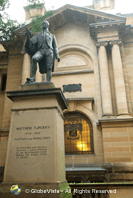Matthew Flinders Statue

Public Art: Matthew Flinders Statue
Sculptor: © William Robert Colton
Date: 1925
Description: Bronze statue atop a marble base. Flinders is depicted in full naval uniform clutching a raised sextant in his right hand.
Location: Next to the Mitchell Wing of the State Library, Macquarie St, Sydney, Australia.

History of the Matthew Flinders Statue: In 1922 the grandson of Flinders, Sir Flinders Petrie, offered a challenge to all the States of Australia. The first State to erect a statue in Flinders’ honor would receive all of his grandfather’s papers.
In 1925 Sydney won the honor and now Flinders’ papers reside in the Mitchell Library.
In 1996, Flinders’s trusty companion of many years, Trim the Cat, was also immortalised in bronze by sculptor John Cornwell on the window ledge of the Mitchell Library (forever watching Matthew Flinder’s back). Click here to read about Trim the Cat Statue, the adventurous feline.
Inscription:
MATTHEW FLINDERS
1774-1814
CAPTAIN in the ROYAL NAVY
He explored and successfully
charted a large portion
of the Australian Coast
during the years 1796
to 1803
Background of Matthew Flinders: Matthew Flinders was a naval navigator, chart maker and explorer who was the first person to circumnavigate the Australian Continent (New Holland) in the ship ‘Investigator’, in 1802.
Matthew Flinders was born at Donington in Lincolnshire, England on the 16th of March 1774. As a child he dreamed of becoming an explorer after being enthralled by Daniel Defoe’s novel Robinson Crusoe.
By the age of fifteen he had joined the navy and begun training as a navigator. In 1795 he had his first venture to Australia on the ship, HMS Reliance.
In 1801, the British Government invited Flinders to go back from whence he came, to head an expedition to circumnavigate Australia and chart the coastline. He sailed back to Australia as commander of the HMS Investigator and set sail from Sydney in July 1802. By June 1803 he returned to Sydney, having charted the east coast, Western Australia’s coastline (to include Cape Leeuwin and King George Sound) and the Gulf of Carpentaria, thus successfully circumnavigating Australia.
Unfortunately fate was about to take a nasty turn. On his journey back to England in 1803, he set ashore in Mauritius for repairs on his schooner. Unbeknownst to him, England was at war with France (Napoleonic Wars) and he was promptly charged as a spy and interned by the French, in Mauritius.
For seven long years Flinders remained a prisoner on the island. Unfortunately poor old Flinders never quite recovered from his ordeal. Shortly before his death in 1814 he completed a book, ‘Voyage to Terra Australis’. Terra Australis meaning southern land which was derived from the word “auster” which was a Latin name for southern wind. Flinders died at the age of forty on the day his book was published.
It was Matthew Flinders who suggested that the continent take on the name “Australia” which was later adopted in 1824. Click here History of Australia Online to find more info on Matthew Flinders.